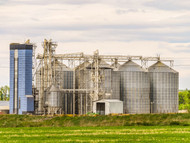Effective Tactics for Preventing Post-Harvest Loss
Published by The Grain Handling Direct Team on Dec 6th 2022
Growing and harvesting food and produce is only half the battle for farmers. After harvest, there are many opportunities for their prized crop to spoil or be ruined by outside forces such as the weather or pests. Below, we’ve put together some credible tactics to help farmers prevent post-harvest loss.
Immediately Storing Grain in On-Farm Storage Post-Harvest
Effective storage is crucial in preserving produce and grain after harvest, as the greatest losses in the farming and agriculture industry occur in storage. Farmers can use community collective grain elevators to store their grain for a fee—which may be cheaper initially but has less long-term value than investing in permanent grain storage equipment.
After harvest, there’s no time to lose in transporting the grain from the field onto the delivery trucks, the farm, and the storage bins. The quicker the grain can be transported into a controlled environment within a grain bin, the better chance that grain has of lasting. Farmers need a fast, sensitive grain bucket elevator to transport the grain from the trucks to the bins without cracking or damaging the sensitive kernels.
Utilizing Grain-Drying Equipment
Once inside the grain storage, there are many ways for things to go wrong and ruin the crop yield—but the most common culprit is moisture buildup. Temperature variation and pest infestation are common problems in grain storage, but the biggest concern for many farmers is keeping the grain dry.
That’s why grain drying equipment is essential to grain storage and the entire post-harvest maintenance of grain and food. Even the slightest bit of moisture and condensation can take hold and spread throughout the crop, along with bacteria. Every farmer with on-farm storage bins needs effective grain-drying equipment, such as fans and aerators, to keep the grain dry and clean.
Monitoring Grain Temperature
Along with keeping the grain dry post-harvest, temperature control is critical to effective grain handling. As we all know, rapid fluctuations in temperature can cause condensation or moisture buildup, which can quickly destroy thousands of bushels in a grain storage bin.
Grain drying equipment helps to remove moisture, but the best strategy is to keep the grain bin at a stable and comfortable temperature using monitoring and temperature controls, such as grain temperature cables. Grain cables in bins give farmers real-time data about their grain’s temperature so they can adjust and ensure their grain is stored at its preferred temperature and remains spoil-free.
As you can see, many tactics for preventing post-harvest loss rely on certain storage and maintenance equipment. If you need to improve your farm’s on-storage capacity or equipment, our team at Grain Handling Direct can help you get set up with the tools you need to reduce your post-harvest losses.

